Return to
main e-meter page
Inside the Mark Super VII
The Hubbard Professional Mark Super VII is
the most sophisticated and expensive e-meter yet developed by the Church of
Scientology. Its retail price in 1995 was US $3,850. It is the standard e-meter
in use today. Although the earlier Mark V model is still offered for sale, for
auditing on the OT levels the Mark Super VII is required .
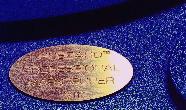 Hubbard Professional Mark Super VII placard
Hubbard Professional Mark Super VII placard
Although the Church of Scientology claims that their e-meters are made of
special high-precision components, the electronic technology in the Mark Super
VII is ordinary 1980s-era VLSI, including an Intel 8051 8-bit microprocessor. An
electrical engineer who examined the meter in November, 1995 estimated that
devices of this type, custom-manufactured and sold in low volume, would normally
retail for around $300 today. That is one twelfth the Church's asking price.
Controls and Indicators
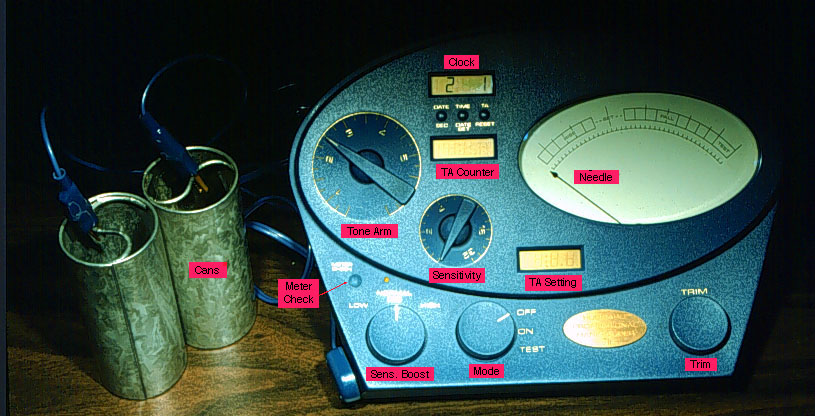
- The Cans: electrodes used to measure skin resistance. Normally one
is held in each hand. (For solo auditing, both are held in one hand.) Because
the quality of the electrical contact depends on one's grip on the electrodes,
there is ample opportunity for tiny, unconscious muscle movements in the
fingers to influence the readings.
- Tone Arm Knob: the primary range control. At a TA setting of 2, the
needle will be at the setpoint when the resistance across the cans is 5,000
ohms. At a TA setting of 3, the needle will be at setpoint at 12,500 ohms. The
meter comes with a pair of reference resistors so that its calibration can be
checked at these two values. At the start of an auditing session the TA should
be between 2 and 3.
- Trim Knob: the secondary range control. Used to fine-tune the range
setting by adjusting the needle slightly to get it to the setpoint. (The
digital display of TA value does not change when the trim knob is moved.)
- Sensitivity Knob: fine tunes the gain on the amplifier to control
the amount of resistance change necessary to obtain a full scale needle
deflection. With too low a sensitivity setting, the needle will just sit at
the setpoint. With too high a setting, every little twitch sends the needle
offscale. A normal sensitivity value is around 5.
- Sensitivity Booster Switch: coarse control of amplifier gain.
Values are Low [16], Normal [32], and High [64].
- Mode Switch: values are Off, On, and Test. In Test mode the needle
should swing rightward and indicate in the ``Test'' region of the scale. If it
fails to reach this region, the batteries are low. The needle should bang
smartly off and then settle against the righthand pin when the E-Meter is
charged.
- Needle: analog needle displaying current flow across the cans: the
inverse of resistance. A leftward movement of the needle is called a ``rise''
(increased resistance); a rightward movement a ``fall''.
- Clock: a digital clock/calendar. This is a separate circuit board,
mounted underneath the main board.
- TA Counter: Cumulative measure of ``downward'' TA motion
(counter-clockwise movement of the knob), displayed digitally. For example,
suppose the auditor moves the TA setting from 2.5 to 2.2. The TA Counter will
increase by 0.3. Only decreases in TA are counted; increases in the TA setting
are ignored by the counter. The total downward TA motion during an auditing
session is recorded on the auditor's worksheet; it is supposed to signify
``release of charge.''
- TA Setting: digital display of current tone arm setting.
- Meter Check Button: A pushbutton that temporarily disconnects the
electrodes from the meter. A tiny amber LED located just above the button
lights up when the electrodes are disconnected. This arrangement allows the
auditor to quickly check the meter's calibration, or to check for a
malfunction if the PC is rockslamming. (The rockslam indication could be
caused by a meter fault, or by the PC touching the cans together. If the meter
checks out okay then the PC really is rockslamming and the auditor must deal
with it.) Pushing the button again reconnects the electrodes and extinguishes
the LED.
Data Plate
 Click for full-scale image
Click for full-scale image
This data plate is affixed to the bottom of
the meter. The serial number and dates have been masked in the image to prevent
the Church's security division (the Office of Special Affairs) from tracing the
unit. The text on the left side of the data plate is a disclaimer that was
required by the US FDA (Food & Drug Administration) after Hubbard's medical
claims grew too outrageous.
On January 4, 1963, however, the Food and Drug Administration
raided the Washington Church... The FDA seized a huge quantity of E-meters and
books. As with "Dianazene," the FDA charged mislabelling... Eventually, the
FDA won their case against the labelling of the E-Meter, and forced the
Scientologists to label it ineffective in the diagnosis or treatment of
disease. The Scientologists failed to thoroughly comply with the ordered
wording...
Jon Atack, A Piece of Blue Sky, p. 154
Here is
the actual wording on the Super Mark VII's data plate:
HUBBARD ELECTROMETER MANUFACTURING
By itself, this meter does nothing. It is solely for the guide of Ministers
of the Church in Confessionals and pastoral counselling. The Electrometer is
not medically or scientifically capable of improving the health or bodily
function of anyone and is for religious use by students and Ministers of the
Church of Scientology only. HUBBARD, E-METER and SCIENTOLOGY are trademarks
and service marks owned by RTC and used with its permission.
Main Assembly
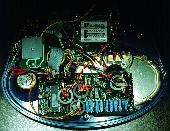 Click for
full-scale image
Click for
full-scale image
This is the main assembly of the Mark Super VII. The
black donut-shaped objects surrounding some wires on the main board are
inductors that suppress electronic interference between the analog and digital
sides of the device. The blue rectangular boxes arranged in a row are ``trim
pots,'' or variable resistors (potentiometers).
An internal serial number plate has been masked in the image to prevent the
Office of Special Affairs from tracing the unit.
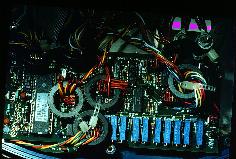 Main circuit board
Main circuit board
Here is a closer view of the main circuit board. It
contains an Intel 8051 microprocessor, an LCD display driver chip for the TA
Setting and TA Counter displays, and various other components.
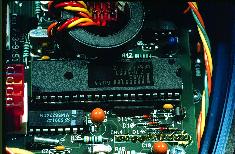 Close-up shot of the Intel 8051 microprocessor
Close-up shot of the Intel 8051 microprocessor
Why Is There a Microprocessor?
The Mark Super VII would seem to be
over-engineered. However, it is capable of more than just measuring resistance
across the cans. It can be connected via a jack on the back to a ``master''
meter, so that a course supervisor can monitor the actions of the auditor from
another room. The unit must therefore be capable of transmitting the current TA
setting, TA counter, and needle position to the master unit several times per
second. Digital technology is an appropriate solution in this case.
The Super Mark VII also accepts a ``remote tone arm:'' a little box with its
own tone arm knob that is placed to the right of the e-meter. The box has a
cable that plugs into another one of the jacks in the back of the meter. Remote
tone arms are for solo auditors, who will want to both work the knob and take
notes with their right hand while holding the cans in their left hand. This is
awkward to do using the meter's built-in tone arm knob, since it is on the far
left side of the unit.
 Back side
of the e-meter
Back side
of the e-meter
This view of the outside back of the e-meter shows the
four jacks. Two are for the charger (allowing for two different plug styles),
one is for the remote tone arm, and one for connection to a course supervisor's
``master'' meter. When the charger is plugged in, a red LED lights up to
indicate that the charging circuit is active.
Also visible in the picture are two rectangular rubber feet, and two of the
three rubber grommets located on the back of the meter. Pulling these grommets
out uncovers the screws that must be removed to open the meter.
Below is a picture of the inside of the back half of the unit, showing the
connections from the jacks to the main and charger circuit boards.
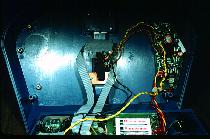 Inside view
of back of e-meter
Inside view
of back of e-meter
Batteries and Charging Circuit
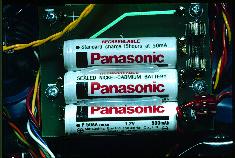 Battery board holds seven batteries (three on top side.)
Battery board holds seven batteries (three on top side.)
See this important note about battery
leakage.
The e-meter uses rechargeable Panasonic NiCad batteries. It comes with a
plug-in charger that converts house current to 12 volts/300 milliamps AC. The
charger plugs into a jack in the back of the unit, which connects to the
charging circuit board:
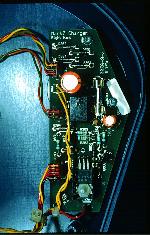 Charging circuit
Charging circuit
Return to main
e-meter page
 Main circuit board
Main circuit board Hubbard Professional Mark Super VII placard
Hubbard Professional Mark Super VII placard

 Click for full-scale image
Click for full-scale image Click for
full-scale image
Click for
full-scale image Main circuit board
Main circuit board Close-up shot of the Intel 8051 microprocessor
Close-up shot of the Intel 8051 microprocessor
 Back side
of the e-meter
Back side
of the e-meter Inside view
of back of e-meter
Inside view
of back of e-meter Battery board holds seven batteries (three on top side.)
Battery board holds seven batteries (three on top side.)